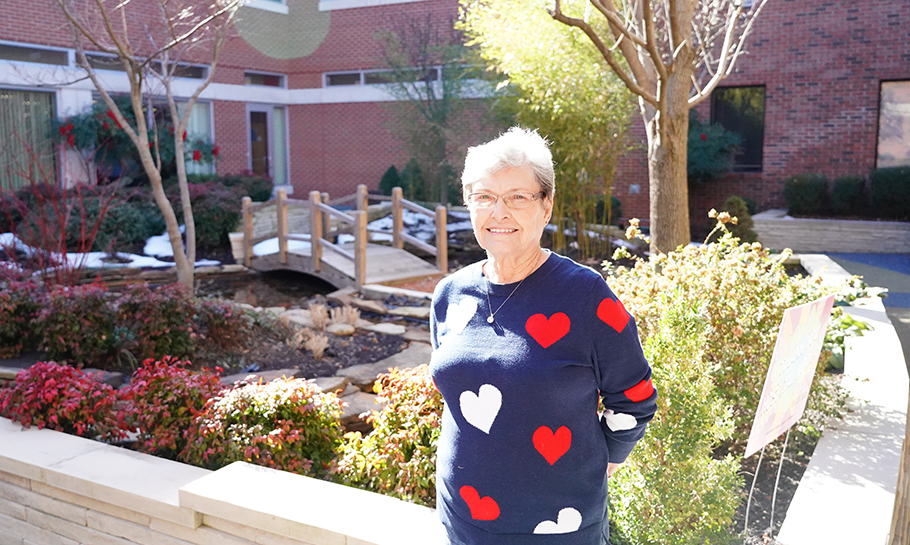Herrin Woman Thriving After Acute Heart Attack

Evelyn Williams stands outside SIH Herrin Hospital in February 2022
About an hour. That's the time it took from the emergency department at SIH Herrin Hospital to the cardiac catheterization lab at SIH Memorial Hospital to save a Herrin woman's life. The impressive 61-minute door-to-balloon time measures the second Evelyn Williams arrived at Herrin to the moment interventional cardiologists opened a blocked artery during a major heart attack last year.
Early Symptoms
Williams had experienced bouts of sleepiness for quite some time but never attributed it to anything serious.
“It was the last Sunday in January. The only thing I had done that day was throw a load of clothes in the washer and clean the kitchen,” she said.
She went back to bed. Around 11 a.m., her husband, Terry, called her to come and eat brunch. She took a couple of bites, felt nauseous and broke out into a sweat.
“I remember saying, ‘honey, I need to go lie down.’”
Soon after, she began yelling for Terry. Her arms were hurting. He gave her four baby aspirins and took her to SIH Herrin Hospital.
STAT Heart in Action
When Williams arrived at Herrin, she was suffering from a STEMI (ST-Elevation Myocardial Infarction) with complete heart blockages that progressed into cardiac arrest - a very serious heart attack. Her heart rate was slowing down, beating 30 - 40 beats per minute. Emergency medicine providers at Herrin enacted the SIH STAT Heart, a rapid response protocol designed to get patients to the cardiac catherization lab at SIH Memorial Hospital of Carbondale. Once there, interventional cardiologists discovered Williams had a 99 percent blockage in the artery which caused the heart attack and 95 percent and 80 percent blockages in other arteries.
Krishna Cherukuri, MD, interventional cardiologist, explained that once Williams was on the table, she flatlined. Dr. Cherukuri inserted a temporary pacemaker and placed a stent in the right coronary artery which caused the heart attack. She was in cardiogenic shock (weakened heart muscle due to the heart attack and multiple blockages). At that point, Dr. Cherukuri placed an Impella (“world's smallest heart pump") to help support the heart muscle and supply blood to Williams’s body.
“It supported her quite well,” said Dr. Cherukuri.
The following day, Williams underwent surgery for the placement of two more stents and the Impella removal. Dr. Cherukuri said Williams was a very lucky woman to be at a hospital when she suffered cardiac arrest.
“Fortunately, she was in a place where they could literally start CPR right away,” said Dr. Cherukuri. “If this had happened out of a hospital, her chances for survival would have gone down dramatically."
Williams had no risk factors. She’d quit smoking over 35 years ago and has no weight issues. She takes medication for high blood pressure, which she attributed to having breast cancer 40 years ago.
Dr. Cherukuri said some people have risks they have no control over, such as genetics and age. However, he said there are things one can do to avoid heart disease, such as regular exercise, eating healthy, not smoking and avoiding stress.
Reflections and Teamwork: Commitment to Care
Dr. Cherukuri feels elated every time he sees Williams.
“I feel joyful that the team that was there that day played a crucial role in getting her out after having such a massive heart attack. She is very fortunate to have a team to get her from death to a smile on her face and discharged,” reflected Dr. Cherukuri.
“Before, all I wanted to do was sleep. Now, I can’t even take a nap. I have so much energy,” Williams said.
She hopes her sharing her story may help someone else get the care they need.
“If you’re having any kind of symptoms you need to get checked. Don’t wait, get to the doctor.”
When the weather warms up, the Williams’ will be taking to the road on their motorcycle – one of their things to do.
“I am blessed. The doctors and nurses that saved my life are all sweethearts. They treated me great.”